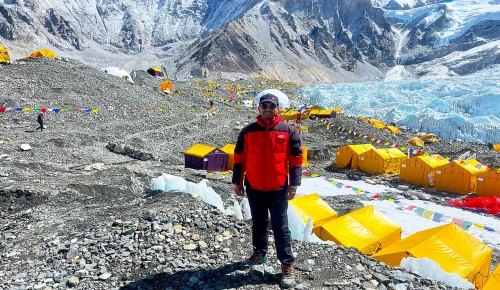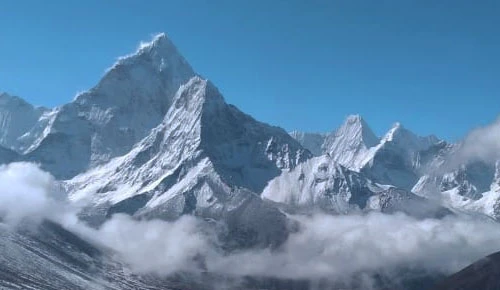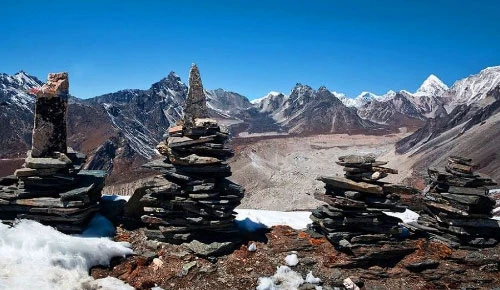Ghorepani Poonhill Trek Cost
Ghorepani Poonhill is a popular and breathtakingly beautiful trekking route located in the Annapurna region of Nepal. The trek lasts for 5 days and takes you through lush forests and charming villages. The trek offers stunning panoramic views of the Himalayan mountains, including Annapurna and Dhaulagiri.
While planning a trek in Nepal, budget is the most important thing. Being prepared with a clear budget helps you manage expenses effectively, avoid overspending, and focus on the experience without financial worries.
The purpose of this blog is to provide valuable insights and practical tips about the costs of the Ghorepani Poonhill Trek. Whether you're a budget-conscious traveller or simply want to make the most of your adventure, this blog will help you understand your budget.

Table of Contents
Cost of Ghorepani Poonhill Trek for 2026
The cost of this trek for the full package with Nepal Trek Adventure is $490 (Check the price of Ghorepani Poon Hill trek). This comprehensive package includes essential elements such as trekking permits, TIMS cards (Trekkers' Information Management System), guide and porter services, a round-trip flight from Kathmandu to Pokhara, comfortable accommodation along the trek route, and meals and drinks during the journey.
While the package covers most expenses, it's essential to consider additional costs not included in the package. These may involve travel insurance, visa fees for entering Nepal, trekking equipment such as proper hiking boots, clothing, and other personal expenses.
Having a knowledgeable guide is highly recommended for this trek. They provide valuable insights into the region's culture, history, and nature. They ensure your safety, help navigate the trails, and make the experience more enriching and enjoyable.
Transportation Cost
Transportation from Kathmandu to Pokhara:
After arriving in Kathmandu, you'll need to travel to Pokhara, the gateway to many popular treks in Nepal, including this trek. The most common transportation options are domestic flights and buses.
| Mode of Transport | Price Range (in USD) |
|---|---|
| Domestic Flight | $120 to $150 |
| Tourist Bus | $15 to $20 |
Please note that prices may vary depending on various factors, such as the time of booking, season, and availability. It's always a good idea to check for the most up-to-date prices before making any travel arrangements.
Options for Reaching the Trek Starting Point:
This trek usually starts from Nayapul. From Pokhara, there are different modes of transportation available, which you can choose as per your preference.
| Mode of Transport | Fare (in USD) |
|---|---|
| Car / Jeep / Taxi | $35 |
| Bus (Private) | $120 |
| Hiace / Van (Private) | $60 |
Choosing the right transportation option depends on your budget, time constraints, and personal preferences. Regardless of your choice, the journey from Kathmandu to Pokhara and onward to the trek starting point will be filled with picturesque views and excitement as you prepare for the unforgettable experience of the trek.
Accommodation Cost
The cost of accommodation during this trek is generally quite affordable, making it an attractive choice for budget-conscious trekkers. On average, a night's stay at a teahouse lodge can range from no cost up to $40, depending on several factors such as the location, level of comfort, and availability of amenities.
In the lower end of the price range, you can expect basic lodging with simple twin beds or dormitory-style rooms. These lodges might have shared bathrooms with basic facilities.
If you are willing to spend a bit more, you can find teahouse lodges with better amenities, such as private rooms, attached bathrooms, and even hot showers, which can be quite a luxury during a trek.
It's essential to keep in mind that prices may vary slightly from season to season. So you can tell us previously about your requirements of the room so that we can book it for you in advance for the required period of time to make you comfortable, or you can easily book your room on the spot after searching a few hotels or lodges over there.
Food and Drinks Cost

Food and drinks are essential considerations when budgeting for the trek. In the teahouses along the trail, you can expect to find a variety of meals to fuel your journey. On average, a meal may cost between $10 to $25 USD per day, depending on the location and the type of food you choose. The meals are usually simple and hearty, with options like rice, dal (lentil soup), noodles, momo (dumplings), and local vegetables.
For breakfast, you can enjoy a plate of steaming hot Tibetan bread, porridge, or eggs with tea or coffee, which typically costs around $3 to $5 USD. Don't forget to try the traditional Nepali tea called "chai," a favorite among trekkers!
To stay hydrated, bottled water is available along the trek but can be expensive due to transportation costs. It is more budget-friendly to bring a reusable water bottle and refill it with boiled or purified water, available at the teahouses for a minimal fee.
Snacks like energy bars, chocolate, and packaged noodles are also available, but they can be pricier compared to buying them in the city. Consider bringing some snacks from Pokhara or Kathmandu to save on costs.
In some teahouses, you might find the option of purchasing a full-meal package for breakfast, lunch, and dinner at a fixed price. This can be a convenient way to manage your food expenses during the trek.
Remember that the higher you go on the trail, the more expensive the food becomes due to transportation difficulties and limited supplies. So, it's a good idea to budget accordingly and carry some extra cash for unexpected expenses.
Hiring Guides and Porters
Hiring guides and porters can greatly enhance your experience and ease the burden of carrying heavy loads.
Guides are experienced and knowledgeable individuals who provide valuable insights into the local culture, history, and natural wonders along the trek. They are skilled at navigating the trails and can ensure your safety throughout the journey.
Porters, on the other hand, are essential for carrying your heavy backpacks, allowing you to enjoy the trek without the strain of lugging your belongings. They are strong and accustomed to the altitude, making them ideal for carrying heavy loads in mountainous terrain.
Hiring guides and porters also positively impacts the local communities by contributing to the region's economy. Many guides and porters come from the local villages, so by hiring them, you support their livelihoods and the sustainability of the trekking industry.
Keep in mind that hiring guides and porters comes with an additional cost, but it's often a worthy investment for the added convenience, safety, and cultural enrichment they provide. Their hard work and bravery cost around $25 to $30 per day. They will carry about 20 kg up to a maximum of 25 kg of loads and walk along with you.
Cost of Trekking Permit and TIMS Card
When trekking in Nepal, including trekking to Ghorepani, you'll need two essential permits: the TIMS (Trekkers' Information Management System) card and the Annapurna Conservation Area Permit (ACAP). These permits are necessary to ensure your safety and preserve the natural beauty of the region.
| Permit Type | Cost (USD) |
|---|---|
| Annapurna Conservation Area Permit (ACAP) | around $25 |
| Trekkers' Information Management System (TIMS) Card (for individual trekkers) | around $20 |
Please note that permit costs may vary, and it's essential to check for the latest fees before embarking on your trek.
Apart from the main permits, some areas within the Annapurna Conservation Area might require additional entry fees. For example, if you decide to visit the Poon Hill viewpoint, there might be separate fees applicable.
Remember to carry your permits at all times during the trek, as they may be checked at various checkpoints to ensure compliance with local regulations. The funds collected from these permits go towards conservation efforts, maintaining the trails, and supporting local communities. By obtaining the required permits and paying the necessary fees, you contribute to the sustainable development of the region and help protect its natural resources for future generations.
Other Costs
Travel Insurance:
Travel insurance is essential for your trip. It provides coverage for unexpected events such as medical emergencies, trip cancellations, and lost baggage. Having travel insurance ensures peace of mind throughout your journey, and it's a small cost compared to potential expenses in case of emergencies.
Equipment Rental Costs:
If you don't have all the necessary trekking gear, don't worry! Many trekking agencies and teahouses offer equipment rental services. Items like trekking poles, sleeping bags, and jackets can be rented at reasonable prices. Renting equipment allows you to save money on buying expensive gear for one-time use.
Tips and Gratuities:
Tipping is a customary practice in the Nepalese trekking culture to show appreciation for the guides and porters' hard work and support during the journey. While there's no fixed amount, it's customary to tip around 15-20% of the trek's cost. Feel free to tip more if you feel the service was exceptional. Remember, small gestures of gratitude can make a big difference in the lives of the local guides and porters.
Miscellaneous Cost during the trek
In the Himalayan area, costs for extra activities and services are generally higher due to the challenging conditions and investments made in local projects. Some additional tasks include:
| Amenity | Cost Range (in USD) |
|---|---|
| Boiled Water (per liter) | $1 to $3 |
| Charging Board (per hour) | $1 to $3 |
| Internet Access (Prepaid Card) | $6 to $10 |
| Warm Heating System | $1 to $3 |
These extra costs are necessary to ensure a comfortable and well-serviced experience in such challenging environments.
Conclusion
Nepal Trek Adventure offers affordable and customizable trekking packages with a skilled and friendly team to ensure your comfort and safety. We provide flexible dates and schedules for both independent and organized group treks. Our experienced guides and porters will make your trip to Nepal truly memorable.
We hope the above information helps you a lot in making a choice about whether to go on an independent trek, join an organized group, or go on a private trek with our teammates.
If you have made a decision on taking our fixed departure or private departure, then see our all-inclusive packages for the Ghorepani Poon Hill Trek.








